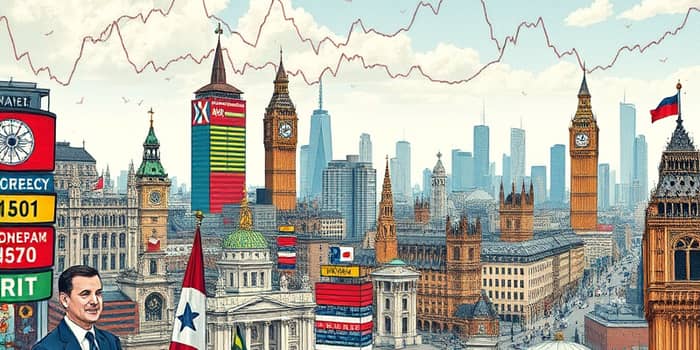Political events, from high-stakes elections to sudden policy shifts, have the power to reshape financial markets overnight. By creating uncertainty and prompting rapid reassessments, these events often lead to sharp short-term fluctuations that challenge investors and institutions alike.
Understanding the link between politics and volatility is essential for anyone engaged with markets today. This article explores key event types, underlying mechanisms, historical examples, and practical strategies to help investors navigate turbulent times with confidence.
Understanding Political Uncertainty
Political uncertainty arises when market participants lack clarity about future policy directions or geopolitical outcomes. In such periods, risk perception intensifies, prompting investors to seek refuge in safer assets. This collective behavior can amplify price swings across asset classes.
While volatility driven by politics is often most pronounced in the short term, the broader economic and policy environment determines whether markets revert quickly or remain unsettled for extended periods. By dissecting the sources of uncertainty, investors can better anticipate potential market reactions.
Types of Political Events and Their Impacts
Political events come in many forms, each carrying distinct implications for markets. Below, we highlight the most influential categories and their typical market effects.
- Elections and Transitions: Competitive elections with divergent policy platforms heighten volatility. Pre-election uncertainty often depresses asset prices until outcomes are clear.
- Geopolitical Conflicts: Military actions or territorial disputes trigger immediate sell-offs in affected sectors, particularly energy and commodities.
- Policy Announcements: Sudden regulatory reforms or tariff impositions can cause sizable losses in vulnerable markets, only to partially recover once the initial shock subsides.
- Political Instability: Frequent leadership changes or cabinet reshuffles erode investor confidence, leading to sustained market unease.
By recognizing these event types, investors can tailor their risk management approaches to the expected volatility patterns each scenario produces.
Mechanisms Driving Market Reactions
Three primary channels explain how political events translate into market movements:
- Investor Sentiment Shifts: Uncertainty elevates perceived risk, driving flows into safe-haven assets like gold and government bonds.
- Economic Policy Uncertainty: Higher uncertainty dampens investment and consumer spending, weakening equity performance and economic growth projections.
- Information Flow Dynamics: Rapid developments force traders to update valuations frequently, creating volatility spikes, especially in high-liquidity markets.
Sectorial and regional effects also arise when specific policies disproportionately affect certain industries or countries, amplifying localized price swings.
Historical Examples and Data Insights
Examining past episodes sheds light on typical market behavior around political shocks. Below is a summary of key events, their market impacts, and supporting data:
These cases illustrate a common pattern: an initial downturn driven by fear, followed by a rebound as clarity emerges and fundamentals re-assert themselves.
Practical Strategies for Investors
While political shocks cannot be predicted with certainty, certain tactics can help manage and capitalize on volatility:
- Diversifying Portfolios Effectively: Spread exposure across asset classes and geographies to cushion region-specific shocks.
- Focusing on Long-Term Fundamentals: Emphasize quality companies with strong balance sheets that can weather policy shifts.
- Using Hedging Instruments: Options, futures, and volatility products provide protection during sharp market moves.
- Monitoring Geopolitical Developments: Stay informed on policy announcements and diplomatic negotiations that could trigger asset revaluations.
By integrating these approaches, investors can turn periods of uncertainty into opportunities for disciplined portfolio building and tactical positioning.
Key Indicators to Monitor
To anticipate volatility spikes, maintain awareness of the following indicators:
- Volatility Indexes (VIX): Often dubbed the “fear gauge,” VIX levels tend to peak during election cycles and international crises.
- Commodity Price Movements: Sharp jumps in oil or gold can signal escalating geopolitical risks.
- Currency Fluctuations: Major currency pairs can react swiftly to policy news, offering early warning of market stress.
- Sector-Specific Indices: Sectors like defense and healthcare may outperform when policy shifts favor increased government spending.
Conclusion
Political events are a perennial source of market volatility, capable of triggering sudden price swings and sector rotations. Yet, they also present windows of opportunity for well-prepared investors who can navigate uncertainty with a clear, strategic approach.
By understanding the event types, reaction mechanisms, and historical precedents outlined here, market participants can build resilient portfolios that withstand turbulence and harness volatility to their advantage.
Ultimately, combining disciplined risk management with informed insights allows investors to face political upheaval not as an insurmountable risk but as a dynamic component of the financial landscape.
References
- https://dailyemerald.com/164087/promotedposts/how-global-events-influence-stock-market-volatility-and-investor-behavior/
- https://www.economicsobservatory.com/how-do-elections-affect-the-stock-market
- https://www.pimco.com/us/en/resources/education/how-political-factors-may-influence-markets
- https://scholarworks.uark.edu/cgi/viewcontent.cgi?article=1141&context=finnuht
- https://focuswealthadvisers.com/how-political-events-shape-market-volatility/
- https://www.bankrate.com/investing/how-geopolitical-events-impact-stock-market/
- https://www.investopedia.com/terms/e/equitymarket.asp










